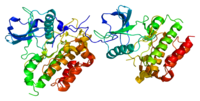
Photo from wikipedia
ABSTRACT HVEM (Herpes Virus Entry Mediator) engagement of BTLA (B and T Lymphocyte Attenuator) triggers inhibitory signals in T cells and could play a role in evading antitumor immunity. Here,… Click to show full abstract
ABSTRACT HVEM (Herpes Virus Entry Mediator) engagement of BTLA (B and T Lymphocyte Attenuator) triggers inhibitory signals in T cells and could play a role in evading antitumor immunity. Here, HVEM expression levels in melanoma metastases were analyzed by immunohistochemistry, correlated with overall survival (OS) in 116 patients, and validated by TCGA transcriptomic data. Coincident expression of HVEM and its ligand BTLA was studied in tumor cells and tumor-infiltrating lymphocytes (TILs) by flow cytometry (n = 21) and immunofluorescence (n = 5). Candidate genes controlling HVEM expression in melanoma were defined by bioinformatics studies and validated by siRNA gene silencing. We found that in patients with AJCC stage III and IV melanoma, OS was poorer in those with high HVEM expression on melanoma cells, than in those with a low expression, by immunohistochemistry (p = .0160) or TCGA transcriptomics (p = .0282). We showed a coincident expression of HVEM at the surface of melanoma cells and of BTLA on TILs. HVEM was more widely expressed than PD-L1 in melanoma cells. From a mechanistic perspective, in contrast to PDL1, HVEM expression did not correlate with an IFNγ signature but with an aggressive gene signature. Interestingly, this signature contained MITF, a key player in melanoma biology, whose expression correlated strongly with HVEM. Finally, siRNA gene silencing validated MITF control of HVEM expression. In conclusion, HVEM expression seems to be a prognosis marker and targeting this axis by checkpoint-inhibitors may be of interest in metastatic melanoma.
Journal Title: Oncoimmunology
Year Published: 2019
Link to full text (if available)
Share on Social Media: Sign Up to like & get
recommendations!